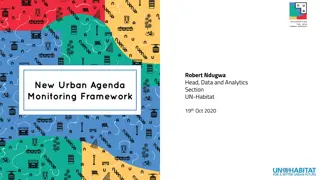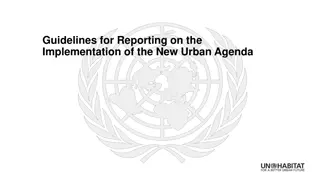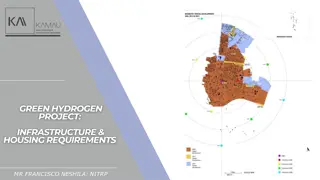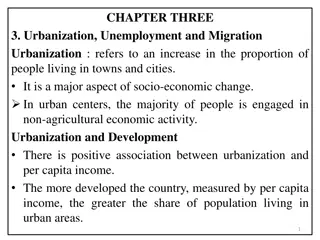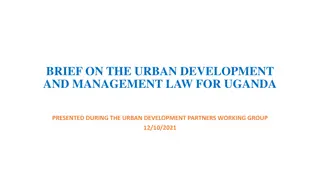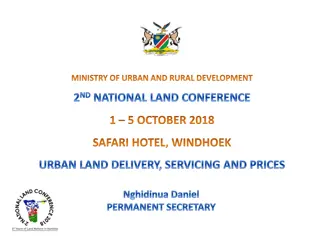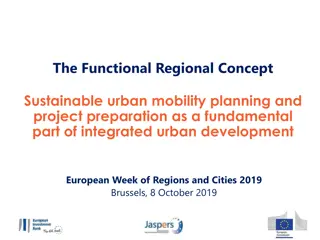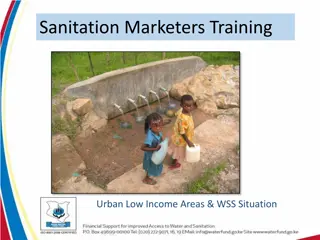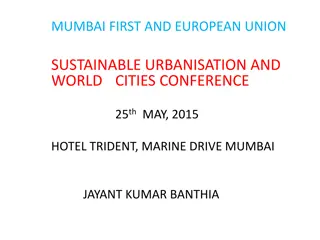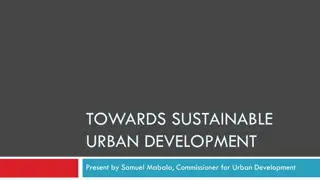Exploring Urban Development Through an International Lens
Join us for a specialized workshop on integrating urban development into national planning strategies. Participants will share insights, discuss best practices, and explore the role of cities in sustainable development. Let's envision a better future together.
Download Presentation

Please find below an Image/Link to download the presentation.
The content on the website is provided AS IS for your information and personal use only. It may not be sold, licensed, or shared on other websites without obtaining consent from the author. Download presentation by click this link. If you encounter any issues during the download, it is possible that the publisher has removed the file from their server.
E N D
Presentation Transcript
Welcome An Urban Lens in National Development Planning Training Workshop
Please introduce yourself Name Department and role Something you hope to discuss here If you won a 1-week trip to any city in the world, where would you go?
Training goal To enhance the transformative power of urbanization for inclusive growth and development. Improved common understanding and skills; collaborative relationships built Better urban narrative; integration in economic policy; broader urban scope within NDP Transformative power of urbanization leveraged for inclusive growth and development Training (concepts, data, co-created knowledge, action plans) 3
Training approach Interactive Contextualized Action-oriented Supported
Training framework: Four themes; Four stages Themes: B: Productive Cities A: Sector Targeting C: National Spatial System D: Coordination & Finance These are entry points for urban issues in national development planning. 7
Training framework: Four themes; Four stages Stages: 1. Diagnostics & analysis 2. Vision, goals & targets 3. Implementation strategies 4. Monitoring & evaluation These are generalized stages. Urban issues should be integrated into each. 8
Three-day training structure Day 1: Intros, conceptual framework and themes Welcome Opening remarks Intro to topic & discussion Intro to four themes & discussions Focus theme selection Four themes Day 2: Deep dive into the focus theme Small groups work through the four stages of NDP & discuss in plenary Four stages Day 3: Action planning Action planning: small group work, plenary discussion & synthesis Action planning final presentations Evaluation Closing 12
Focus theme selection Where are the biggest gaps in the current NDP framework? (Issues not addressed or prioritized)? Where in the NDP are opportunities for improvement (in scope, depth, narrative)? Which issues are the most important for economic development? What area can be feasibly improved in the short-medium term? 13
Action Planning Actions needed to integrate urban issues into national development planning Action Responsibilities Timeline Resources Risks & Mitigation Coordination Plan What will be done? Who will do it? By when? Resources available, needed, opportunities Why the action may fail & how to overcome the risk Who is involved; what coordination method? 1. 2. 3. Etc + Evidence of success (benchmarks) + Monitoring or follow up plan
Ground Rules Respect each other. Keep comments concise. Participate in discussions; Make space for others to participate. Arrive on time; Finish on time Others?
Sample Slides: Day 1 Substantive Presentations
Why integrate urban issues in national development planning? Introduction to the workshop topic Day 1
Why national development planning? Commission of Growth and Development Report success factors: Strong leadership Commitment to stable economy & investment climate Implementation of long-term economic policy Lessons from East Asia: Long-term vision with 5-year development plans Economic growth plus present challenges Administrative process to link economic, sectoral, spatial and budgetary planning More interventionist early on, more market-driven later in development Target labour-intensive industry early, then to heavy industry, then to knowledge and technology-intensive industries 2
The resurgence of national development planning in Africa Initial attempts at national development planning in Africa fell by the wayside during the structural adjustment era. Since the late 1990s, there has been a recognition of the importance of planning, especially reflecting on successes in Asia. Planning can direct resources to strategically important sectors and align public and private investments. African countries are moving away from externally determined priorities to a self-led economic development focus and domesticating global commitments (SDGs) within national development framework. 3
National Development Planning in [country] Add bullet point on longer term vision (ex: Vision 2030: Become a middle income country etc.) Add bullet point on main themes of current NDP Add bullet point on NDP s approach to urbanization (if included in the NDP) 3
The urban narrative in Africa is incomplete Space missing from national economic discourse Economy missing from urban development discourse Urban narrowly equated to housing sector Not enough focus on quality of urbanization However, there are steps in the right direction Agenda 2063, the Common African Position on the Post-2015 Development Agenda and the Common African Position on Habitat III all recognize cities as economic drives. New momentum by African policy makers to address urban issues
Urbanization in [Country] **insert chart showing projected urbanization using data from UNDESA (see sample slide) **note how much the urban population is expected to grow (see sample slide)
Sample Slide: Urbanization in Zambia Zambia's Urban Transition 1950-2050 Between 2015 and 2050, the urban population will increase 3-fold, by nearly 20 million people. 50 Millions 45 40 35 30 25 20 15 (Like adding 8.5 new Lusakas.) 10 5 - Rural population Urban population Data from UNDESA
Why an urban lens? Why now? The scale and speed of urbanization demands proportional attention The way cities are designed and managed impacts economic growth and structural transformation Spatial implications of macroeconomic and sector policies are substantive Opportunities are transitory, and today s policy actions define the future of national economies in the long-term (hard choices) Coordination failure is costly: public, firm and household investments have to be aligned in space Urbanization is multi-sector and complex, should be coordinated
Urbanization and economic development are inextricably linked. Urbanization and income across countries, 2015 120 Urbanization (% of population) [Country name] *adjust to point to country 100 80 60 40 20 0 100 1000 10000 100000 GDP per capita Data: WDI Africa Rest of world
The Urbanization Economic Structural Change Theory of Change Factors contributing to urbanization: - Natural increase - Economic growth (with or without jobs) - Rural push factors Urbanization We are familiar with factors contributing to urbanization.
The Urbanization Economic Structural Change Theory of Change Factors contributing to urbanization: - Natural increase - Economic growth (with or without jobs) - Rural push factors Urbanization: - Thick markets for inputs, goods, labour - Increase in urban labour Structural change & broad-based economic growth What may be less familiar is how urbanization can contribute to structural transformation. This link is not automatic.
The Urbanization Economic Structural Change Theory of Change Factors contributing to urbanization: - Natural increase - Economic growth (with or without jobs) - Rural push factors Urbanization: - Thick markets for inputs, goods, labour - Increase in urban labour Structural change & broad-based economic growth Another central question: One central question: What policy elements can influence this relationship? Policy Framework Moderating Factors What factors moderate this relationship?
The Urbanization Economic Structural Change Theory of Change Factors contributing to urbanization: - Natural increase - Economic growth (with or without jobs) - Rural push factors Urbanization: - Thick markets for inputs, goods, labour - Increase in urban labour Structural change & broad-based economic growth Policy Framework: - Economic targets - Spatial targets - Institutional factors - Investment Moderating Factors: - Productive urban jobs - Urban links to rural productivity - Quality of cities These are the subjects of this training.
The Urbanization Economic Structural Change Theory of Change Factors contributing to urbanization: - Natural increase - Economic growth (with or without jobs) - Rural push factors Urbanization: - Thick markets for inputs, goods, labour - Increase in urban labour Structural change & broad-based economic growth Policy Framework: - Economic targets - Spatial targets - Institutional factors - Investment Moderating Factors: - Productive urban jobs - Urban links to rural productivity - Quality of cities Theme A Theme C Theme D All themes Theme A Themes A, C Theme B
Urbanization and economic development are inextricably linked. Structural transformation requires the movement of labour from lower productivity sectors to high productivity sectors. This entails agricultural modernization (labour shedding), entry of labour into urban sectors (manufacturing and services). National development planning can help create the required urban jobs for this transition. productive sector expansion productivity increase labour
Urbanization and economic development are inextricably linked. Cities host proven productive benefits to firms (agglomeration economies) Urban productivity arises from the proximity and interaction of economic actors. Lowering transaction costs Fostering economies of scale Facilitating sharing and matching (labour, inputs, markets) Facilitating knowledge transfer and resulting in innovation Econometric studies indicate as a city grows by 25%, worker productivity rises 1-2%. This elasticity is higher for specialized cities. (Turok & McGranahan. (2013) Urbanisation and economic growth: the arguments and evidence for Africa and Asia )
Characteristics of Productive Cities Poorly-functioning cities reduce the urban productive advantage - Hard to get land, permits - High transactions costs - Constrained supply -> high cost of living - Jobs-workforce mismatch (skills, location) Well-functioning cities bolster productivity - Property markets work -> location choice - Clear regulations & taxes - Goods markets work - Labour markets work (pooling, skills) Institutions - Easy access to electricity, utilities - Easy commutes, multimodal options - Efficient freight - Outages & unreliable utilities - Long, unpredictable, costly commutes - Slow, inefficient freight Infrastructure - Density & clustering - Knowledge spillovers - Dense markets - Social mix -> economic mobility - Connectivity -> market access - Sprawl -> long, costly travel - Separation reduces knowledge spillovers - Segregation -> poverty traps - Poor connectivity reduces market size & access Spatial layout /urban form 10 Takeaway: Cities -> costs to firms -> productivity & competitiveness
Urbanization challenges Urban population growth can occur without economic growth and without productive job growth. This breakdown can be the result of several factors. Natural resources and agriculture exports without value added creates consumption cities without productive jobs. Natural demographic growth of urban populations without commensurate productive job growth. Cities underperforming due to underinvestment, inadequate infrastructure and services, congestion, crime, segregation, etc. National development planning will shape whether urbanization achieves its economic potential.
NDP is required to coordinate sector strategies and subnational strategies. National Development Planning Sector policies or strategy (industry, agriculture, trade) National urban policy or strategy Local urban and economic development strategies and plans
Four substantive themes B: Productive Cities A: Economic Sector Targeting C: National Spatial System D: Coordination & Finance These are entry points linking cities and national economic development.
Discussion Quick reactions? Clarifications? Gaps in the current NDP process in [country]? Possible action items?
Economic Sector Targeting to leverage the potential of cities and urbanization (Introduction to Theme A)
Key questions for policymakers Which economic sectors will create urban jobs and generate structural transformation? Which economic sectors will leverage and harness urban demand for domestic sector growth? How can cities add value to rural products through forward and backward linkages?
Economic sector targeting in _[country name]_ s current NDP
In Africa, growth is increasingly coming from urban sectors. 7.00% Per capita value added CAGR 2000-2014 6.00% 5.00% 4.00% 3.00% 2.00% 1.00% 0.00% -1.00% -2.00% -3.00% Nigeria Mauritius Cabo Verde Lesotho Liberia Tunisia Senegal Guinea Mozambique Zambia Seychelles Kenya Benin Sierra Leone Namibia Sudan Algeria Cameroon Swaziland Comoros Ethiopia Egypt South Africa Togo Gambia Tanzania Malawi Congo, Rep. Zimbabwe Guinea-Bissau Morocco Uganda Congo, Dem. Rep. Central African Republic Mali Rwanda Mauritania Gabon Botswana Burkina Faso Burundi Data: WDI Agriculture Industry Services
However, not all growth is job-rich. GDP per capita, poverty and natural resource rents 100 Madagascar Malawi Burundi Congo, Dem. Rep. (% at less than $3.20 a day, 2011 PPP) Mozambique 90 Nigeria Guinea-Bissau Rwanda CAR Tanzania Lesotho Sierra Leone 80 Mali Zambia Niger Benin Swaziland Togo Sao Tome and Principe 70 Congo, Rep. Chad Ethiopia Guinea South Sudan Liberia 60 Senegal Angola Poverty Uganda Burkina Faso Cote d'Ivoire Cameroon 50 Djibouti Namibia Zimbabwe Botswana 40 Sudan South Africa Ghana Comoros 30 Cabo Verde Gabon 20 Mauritania Egypt, Arab Rep. Morocco 10 Tunisia Algeria 0 Mauritius Log GDP per capita (US$) Bubble size = Natural resource rents (% of GDP) Data: WDI; Most recent year between 2005 and 2015 with poverty data
Key points on urban jobs Urban populations are growing, with or without jobs (often due to natural increase) Productivity is key Structural transformation requires urban population is working in productive employment Wages (and poverty) depend on productivity Manufacturing and tradable services are productive. However, nontradable and informal service sectors are currently dominating urban job options. Youth budge needs productive urban jobs to become demographic dividend Urban wages are critical for slum amelioration
Productive urban job creation is the primary condition determining whether urbanization will contribute to economic development.
One role of NDPs is to marshal support behind strategic economic sectors. These sectors must create productive urban jobs to leverage the power of urbanization.
Where are urban job creation opportunities in [country name]?
Urbanization creates demand Urban infrastructure Urban housing Urban middle class consumption Urban preferences for manufactured & processed goods Traded, processed, packaged foods FDI is already drawn to African urban consumption
The construction value chain presents job- creation opportunities Urban and Rural Expenditure on Housing, 2010 500 450 400 350 $ per person 300 250 200 150 100 50 - Urban Rural
Urban food consumption also presents opportunities African per capita food imports, select categories and years between 1995 and 2015 1.6 1.4 1.2 1 USD 0.8 0.6 0.4 0.2 0 1995 2000 2005 2010 2015 Bovine, sheep, goat and pig meat Milk and cheese Vegetables - fresh, chilled and frozen Poultry meat Non-alcoholic beverages Chocolate
Case Example: Malaysias early development strategy Post-independence (1960s & 70s) economic strategy designed to move labour to productive sectors. Focus areas: Reducing commodity reliance (rubber & tin) Investment in primary processing industries linked to agriculture, mining, forestry. Products for domestic market (food products, beverages, textiles, printed materials, furniture, rubber products, and building supplies) Intermediate goods (chemicals & transport equipment) Spatial integration and urban livability After success in labour-intensive industries, industrial restructuring ( 70s & 80s), then toward ICT & skill-intensive sectors.
Possible indicators to inform economic sector targeting Labour intensity of priority economic sectors Urban youth unemployment and trend Share of imports in food supply Ratio of raw to processed agriculture exports Manufacturing value added and employment share in GDP Ratio of tradable to nontradable sectors by output, value added and employment
Urbanization vs. employment in industry Urbanization and Employment in Industry, Average of available data 2007-2015 80 2.2 2.0 70 2.6 2.9 2.7 4.1 3.2 60 2.9 3.4 Ratio of urbanization : employment in industry 7.5 50 5.2 1.8 2.8 2.4 4.1 1.4 4.6 40 6.2 2.2 3.6 4.1 5.4 2.6 30 0.6 3.7 1.0 2.1 2.1 20 10 0 Urbanization (% of population) Employment in Industry (% of employment) Data: WDI
Urbanization vs. manufacturing value added Urbanization and Manufacturing Value Added, 2015 100 28 90 80 4 9 10 5 70 3 9 129 Ratio of urbanization : manufacturing value added 4 4 1015 5 60 5 3 3 50 2 5 6 8 22 3 3 6 40 3 3 6 4 5 3 2 30 8 1 4 2 2 20 1 10 0 Nigeria Mauritius Liberia Lesotho Tunisia CAR Equatorial Guinea Guinea Zambia Kenya Cameroon Namibia Benin Sierra Leone Swaziland South Africa Gambia Ghana DRC Ethiopia Congo, Rep. Zimbabwe Malawi Tanzania Sao Tome and Principe Morocco Egypt, Arab Rep. Togo Mozambique Uganda Gabon Mauritania Rwanda Botswana Burkina Faso Chad Burundi Cote d'Ivoire Urbanization (% of population) Manufacturing, value added (% of GDP) Data: WDI
Urban growth vs. manufacturing growth 18 Ratio of urban growth to manufacturing growth 0.2 16 0.3 0.3 14 0.3 0.4 12 0.4 10 0.2 0.91.4 8 0.6 0.70.7 3.61.30.9 0.4 0.84.2 6 0.81.0 1.21.5 1.01.40.91.0 1.1 0.7 1.8 1.9 2.71.1 4 1.10.60.6 1.6 -0.1 1.81.9 2.8 2 4.1 0 -5.4 -2 -4.2 Namibia Nigeria Liberia Tunisia Niger Equatorial Guinea Guinea Mauritius Kenya Zambia Senegal Lesotho Swaziland Benin Sierra Leone Ethiopia Gambia Ghana Egypt CAR DRC Malawi Seychelles Tanzania Cameroon Sudan Comoros Uganda Togo Mozambique South Africa Morocco Zimbabwe Rwanda Mauritania Congo, Rep. Gabon STP Burkina Faso Chad Botswana Burundi Cote d'Ivoire Urban population growth (annual %) Manufacturing, value added (annual % growth) Data: WDI
Ratio of raw to processed food exports Foodstuffs and Vegetable Products as a Percent of Total Exports 45% 40% 35% 30% 25% 20% 15% 10% 5% 0% Cameroon Chad Morocco Uganda Zambia 0.7:1 1:1 3:1 4:1 Ratio raw: processed: 7:1 Raw exports Processed exports Imports Data: UN Comtrade, Observatory of economic complexity







